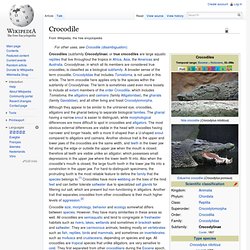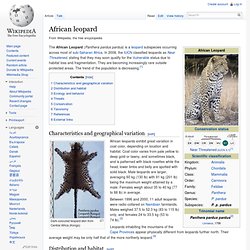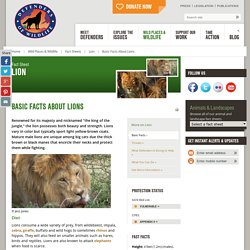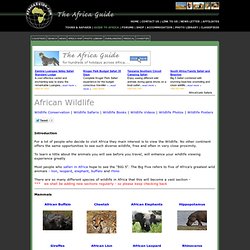

Crocodile. Etymology The word "crocodile" comes from the Ancient Greek κροκόδιλος (crocodilos), "lizard," used in the phrase ho krokódilos tou potamoú, "the lizard of the (Nile) river".

There are several variant Greek forms of the word attested, including the later form κροκόδειλος (crocodeilos)[4] found cited in many English reference works.[5] In the Koine Greek of Roman times, crocodilos and crocodeilos would have been pronounced identically, and either or both may be the source of the Latinized form crocodīlus used by the ancient Romans. Crocodilos or crocodeilos is a compound of krokè ("pebbles"), and drilos/dreilos ("worm"), although drilos is only attested as a colloquial term for "penis".[5] It is ascribed to Herodotus, and supposedly describes the basking habits of the Egyptian crocodile.[6] Species Distribution of crocodiles A total of 14 extant species have been recognized. Characteristics Crocodiles, like dinosaurs, have the abdominal ribs modified into gastralia. Size Teeth Senses Vision Touch. African Crocodile in Botswana.
Wildlife Finder - Crocodiles facts, pictures & stunning videos. Hippopotamus. The hippopotamus (Hippopotamus amphibius), or hippo, from the ancient Greek for "river horse" (ἱπποπόταμος), is a large, mostly herbivorous mammal in sub-Saharan Africa, and one of only two extant species in the family Hippopotamidae (the other is the pygmy hippopotamus).

After the elephant and rhinoceros, the hippopotamus is the third-largest type of land mammal and the heaviest extant artiodactyl. Despite their physical resemblance to pigs and other terrestrial even-toed ungulates, their closest living relatives are cetaceans (whales, porpoises, etc.) from which they diverged about 55 million years ago. The common ancestor of whales and hippos split from other even-toed ungulates around 60 million years ago. Wildlife Finder - Hippopotamus facts, pictures & stunning videos. Wildebeest. The wildebeest, also called the gnu is an antelope in the genus Connochaetes.

It belongs to the family Bovidae, which includes antelopes, cattle, goats, sheep and other even-toed horned ungulates. Connochaetes includes two species, both native to Africa: the black wildebeest, or white-tailed gnu (C. gnou); and the blue wildebeest, or brindled gnu (C. taurinus). Fossil records suggest these two species diverged about one million years ago, resulting in northern and southern species. Wildlife Finder - Blue wildebeest facts, pictures & stunning videos. African Leopard. The African Leopard (Panthera pardus pardus) is a leopard subspecies occurring across most of sub-Saharan Africa.

In 2008, the IUCN classified leopards as Near Threatened, stating that they may soon qualify for the Vulnerable status due to habitat loss and fragmentation. They are becoming increasingly rare outside protected areas. The trend of the population is decreasing.[1] Characteristics and geographical variation[edit] Dark-coloured leopard skin from Central Africa (Kongo) African leopards exhibit great variation in coat color, depending on location and habitat.
Between 1996 and 2000, 11 adult leopards were radio-collared on Namibian farmlands. Leopards inhabiting the mountains of the Cape Provinces appear physically different from leopards further north. Distribution and habitat[edit] African Leopards. African leopards are probably the most common of the leopard subspecies that has a minimal conservation concern.

Habitat They are widely seen in Africa particularly in the mountainous forests, grasslands, and even the savannahs with the exception of the extreme sandy deserts. However, they would prefer the undisturbed rainforest where they can freely hunt their prey and escape from humans. In the summer heat, they can be seen in caves or draped over a branch of a tree. Physical Characteristics The physical characteristic of leopards may vary depending on its habitat or location. They are covered with black rosettes with no spots where the pattern is unique in every individual. Those found in the East Africa have a more circular spot, while in Southern Africa, African leopards have square spots.
They prefer to live in solitude, and it is very unlikely that they would be seen in groups. A Leopard in Kruger National Park, S.A. Hunting for Survival They move with caution. Leopard Cubs. African Lion Facts - Panthera leo - Defenders of Wildlife - Defenders of Wildlife. Renowned for its majesty and nicknamed "the king of the jungle," the lion possesses both beauty and strength.

Lions vary in color but typically sport light yellow-brown coats. Mature male lions are unique among big cats due the thick brown or black manes that encircle their necks and protect them while fighting. © Jess Jones Diet. African Lions, African Lion Pictures, African Lion Facts, African Cats. Lions are the only cats that live in groups, which are called prides.

Prides are family units that may include up to three males, a dozen or so females, and their young. All of a pride's lionesses are related, and female cubs typically stay with the group as they age. Young males eventually leave and establish their own prides by taking over a group headed by another male. Only male lions boast manes, the impressive fringe of long hair that encircles their heads. Males defend the pride's territory, which may include some 100 square miles (259 square kilometers) of grasslands, scrub, or open woodlands. Female lions are the pride's primary hunters. African Wildlife - Animals in Africa. African Wildlife Wildlife Conservation | Wildlife Safaris | Wildlife Books | Wildlife Videos | Wildlife Photos | Wildlife Posters Introduction For a lot of people who decide to visit Africa they main interest is to view the Wildlife.

No other continent offers the same opportunities to see such diverse wildlife, free and often in very close proximity. To learn a little about the animals you will see before you travel, will enhance your wildlife viewing experience greatly Most people who safari in Africa hope to see the "BIG 5". There are so many different species of wildlife in Africa that this will become a vast section - *** we shall be adding new sections regularly - so please keep checking back Mammals. Conserving Wildlife: Wildlife Gallery.